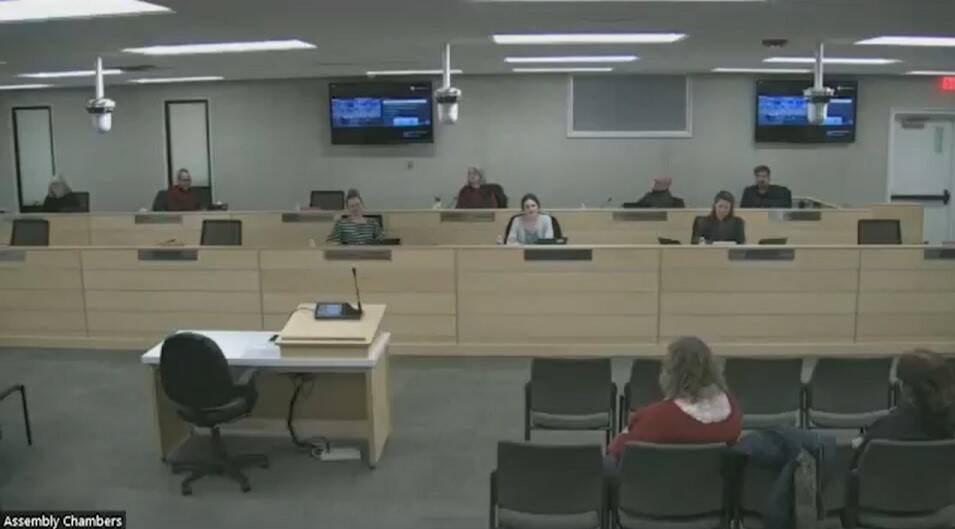Homer High School’s student government continues to lead efforts to change the school’s dress code regulations disallowing Salty Dawg apparel in the school. A resolution made by the student government earlier this academic year has been presented to the Alaska Association for Student Governments, the KPBSD Board of Education, and the Homer High School Site Council, where it has been met with almost entirely unanimous support.
“It does not usually happen where it passes as unanimously as it did [at AASG]. We got a lot of support from schools, from other students in different schools from around Alaska saying that it was an issue in their school as well,” said student body secretary Cecilia Fitzpatrick during their regular meeting on Thursday, Feb. 23.
The resolution and rules change process at the high school level begins when students have an idea about an issue they’d like to address, according to Homer High School social studies teachers and student government faculty sponsor Michelle Borland.
“Usually at the beginning of the year we do some brainstorming and come up with ideas. Then the students do the research and make a committee, and that committee works on the resolution,” Borland said. “Then we try to take it to the state student council conference and that’s a really great chance to review [the resolution] and have peers look at it … edit it, suggest changes.”
Following review at the Alaska Association for Student Governments, the student government brings the resolution back to Homer High School and “[tries] to implement the change and see what will happen with it there,” according to Borland. Past resolutions passed by the Homer High student council centered on “ongoing issues” such as funding, recycling, and allowing students to hold dances again after COVID slowed enough to restart school activities and sports.
Fitzpatrick noted that the regulation banning Salty Dawg apparel in the school has been “a highly contested issue with students” for a long time. The HHS student handbook bans students from wearing clothing that “advertises or suggests the use of alcoholic beverages, illegal drugs, or tobacco,” and explicitly uses Salty Dawg sweatshirts and hoodies as an example of the above non-permitted. However, the student body generally views Homer’s Salty Dawg Saloon as an important local historical landmark and major tourist attraction, rather than an implicit endorsement of alcohol or alcohol consumption.
The resolution, which was passed unanimously on Oct. 22 by the General Assembly of AASG, notes that in prohibiting clothing advertising the use of alcoholic beverages, the HHS handbook specifically targets apparel from Salty Dawg and does not explicitly list other, similar local establishments. It further notes that Salty Dawg merchandise is already widely prevalent in the greater Homer community and is “solely available for students to purchase in the adjacent ‘Salty Girls’ gift shop or online, and not in the building that serves alcohol.” Salty Dawg Saloon also requires customers to provide ID to enter the establishment, effectively barring entrance to Homer’s underage student population.
Homer High School administration has voiced support for excepting Salty Dawg apparel from the dress code but, as of the time of the resolution’s passing by the HHS student council general assembly, has been “unsuccessful in resolving this issue with the Kenai Peninsula Borough School District,” according to the resolution. Principal Doug Waclawski echoed support for the rule change and the student body’s efforts during an interview earlier in February.
“I’m very supportive of the students and proud of them for going through the procedure [to change the policy]. That’s what I want them to do,” he said. “As long as it’s a rule, we’re going to enforce it. But I hope they’re successful.”
The student government presented the resolution to the KPBSD School Board on Feb. 6, where it was met with “strong support from the local representatives,” according to Fitzpatrick.
“I think we passed with almost unanimous consent at that council,” student body vice president Damon Weisser said.
The student government also brought the resolution to the Homer High School site council on Feb. 7. KPBSD School Board vice president Zen Kelly attended the site council meeting in support of the resolution, according to Weisser.
This resolution pertains specifically to Homer High School’s dress code policy; however, its success will set precedent for other schools across Alaska experiencing the same or a similar issue to be better able to change their policy.
The desired changes expressed in the resolution are not yet finalized, as they relate to dress code rules set in the student handbook and therefore the handbook itself must be revised. The process for approving and implementing student-initiated policy changes is a long one, and while the Homer High student government is ready to take the next step towards having their resolution implemented, the process is temporarily paused.
“But it’s been fun to work on,” Fitzpatrick said. “It’s an issue that a lot of students are passionate about and it’s something that we’ve been trying to deal with for a long time. It’s also been really great learning the ins and outs of how the local government here works, how you can actually change stuff. So we’re waiting for a little bit right now, but we’ll be back at it soon.”
The full resolution can be read at aasg.org/wp-content/uploads/Resolution-14-Fall-2022.pdf.



